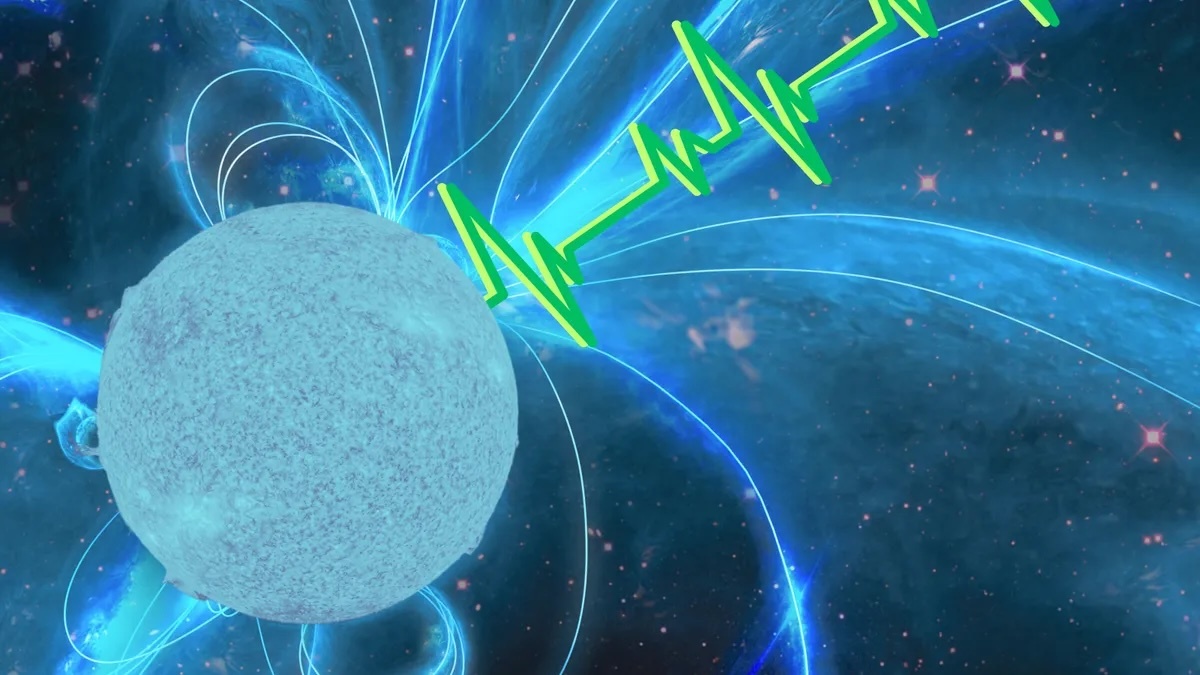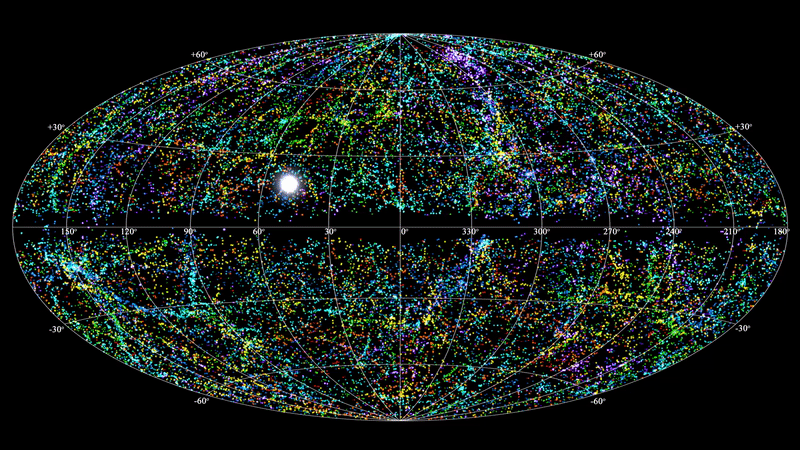8.08.2024
Scientists may be closing in on highly magnetized neutron stars or "magnetars" as the solution to the fast radio burst mystery.

An illustration shows a neutron star pulsar blasting out fast radio burst. (Image credit: Robert Lea (created with Canva)/NASA)
Scientists have found more evidence linking rapid blasts of energy that are brighter than entire galaxies to highly magnetic dead stars or "magnetars." These neutron stars would have to possess winds of charged particles strong enough to inflate bubbles of surrounding super-heated ionized gas, or plasma.
Erupting and disappearing in milliseconds, these blasts, or fast radio bursts(FRBs), can emit as much energy in a fraction of a second that the sun releases in three days. Clearly, scientists are keen to determine the source of these powerful explosions of energy, but their origins have been frustratingly elusive since 2017, when the first FRB was found in data from the Parkes Observatory in Australia after being detected in 2001.
This source has been elusive because most FRBs briefly flash once and then vanish. Compounding this mystery is the fact that a very small sample of FRBs erupt more than once, prompting scientists to ask if repeating and non-repeating FRBs can have the same origin or if this is a bifurcated puzzle.
To investigate the mystery of FRB origins, a team of astronomers directed the Very Large Telescope (VLT) in the Atacama Desert of northern Chile at FRB 20201124A. Originating from a source estimated to be 1.3 billion light-years away, FRB 20201124A is a particularly active radio burst that has experienced several episodes of explosive activity during the past years.
"FRBs are among the most violent phenomena in the universe, providing information about physics principles in extreme conditions," team leader Gabriele Bruni, researcher at the National Institute for Astrophysics, told Space.com. "All in all, they can be considered cosmic laboratories to test our theories and discover new physics."
Bruni explained that he and the team could detect the faintest radio continuum emission, electromagnetic radiation over a range of wavelengths, associated with FRB so far. This allowed them to confirm the FRB origin suggested by their "nebular model." Said model predicts that the radio continuum is produced by a bubble of plasma surrounding the central engine responsible for the bursts, inflated by winds of charged particles called the "nebular wind" blowing from that object.
"The discovery allows us to ascribe the origin of the fast radio bursts to the remnant of massive stars," Bruni said. "Our discovery about continuum emission associated with some FRB allows us to better understand the environment of their source, implying that the central engine producing the bursts must also be able to inflate a plasma bubble through winds.
"The best candidate to explain these properties so far is a magnetar, an extremely magnetized neutron star."
Dead stars are blowing bubbles
Magnetars, like all neutron stars, are born when once-massive stars with masses at least eight times that of the sun die. Stellar "death" comes about after stars exhaust their fuel supplies after spending millions or even billions of years burning nuclear fuel in their cores and converting it to heavier elements. That is usually when iron has been forged and fills the core, this being an element no star is capable of fusing into heavier elements.
The end of that fuel supply also ends the outward energy flow coming from the core of the star. This pressure of that outward radiation is what supports a star against the inward force of its own gravity for its entire life, keeping it in a delicate state of equilibrium.
As this equilibrium is shattered, the star's core collapses sending shockwaves into the outer layers of the star. This causes these layers to be blown apart and dispersed in a powerful supernova explosion while the inner core collapses upon itself. The result is a stellar remnant that has between one and two times the mass of the sun squeezed into a sphere with a diameter of just around 12 miles (19 kilometers.)
That is a neutron star.
Not only does this entire situation create neutron star matter so dense that a teaspoon of it would weigh something like 1 billion tons, but, like an ice skater drawing in their arms to spin faster, the rapidly shrinking radius increases the stellar remnant's high spin rate. As a result, some young neutron stars can rotate as fast as 700 times per second.
The collapse also pushes together the magnetic field lines of the dying star. As the field lines are compressed together, this can create the universe's most powerful magnetic fields. There are neutron stars out there that boast a powerful magnetic field of such strength they qualify for their own category of celestial object.
Those neutron stars are the magnetars.
As mentioned above, magnetars have long been posited as the source of repeating FRBs, but scientists haven't been able to pinpoint just how that is happening. Suggestions have included disparities between the interior and outer crust of a neutron star, causing it to "glitch" or momentarily speed up its rotation, and starquakes rippling through the neutron-rich sea of matter within a neutron star, releasing energy when they break their surface.

"We started observing FRB20201124A in April 2021, and our deep observations with the VLA allowed us to detect its faint continuum emission in the radio," Bruni said. "That allowed us to expand the probed luminosity versus rotation measure, a way to estimate the magnetization and ionization of the medium surrounding the FRB source that is foreseen by the nebular model, confirming its validity."
Thus, this new research suggests there is a link between nebular winds strong enough to inflate bubbles of plasma and the emission of FRBs.
"Our result could prove the 'magnetoionic medium,' the combination of plasma and magnetic fields around the FRB engine, verifying that the continuum emission is produced in its immediate surroundings," Bruni said.
While providing evidence to strengthen the link between FRBs and magnetars, this model doesn't yet provide an answer to the question of whether repeating and non-repeating FRBs have the same sources.
"This is a question under investigation by the astronomical community, with some indication that all FRBs should be able to undergo repeating episodes of bursting activity, but only the strongest can be observed," Bruni said. "Pushing the VLA to its limit, we could get a feeling about how many more FRB could be investigated with the increased sensitivity of the next generation radio telescopes.
"We have set up a campaign to detect more 'plasma bubbles' surrounding other FRBs, improving the nebula model and constraining their physical properties."
The team's research was published on Wednesday (Aug. 7) in the journal Nature.
Quelle: SC
